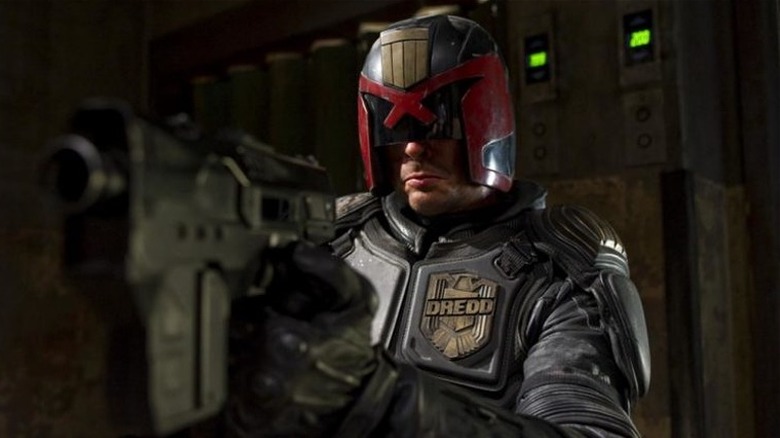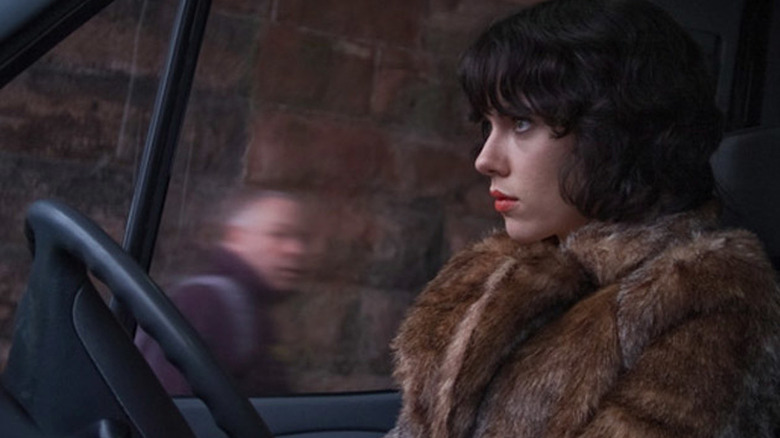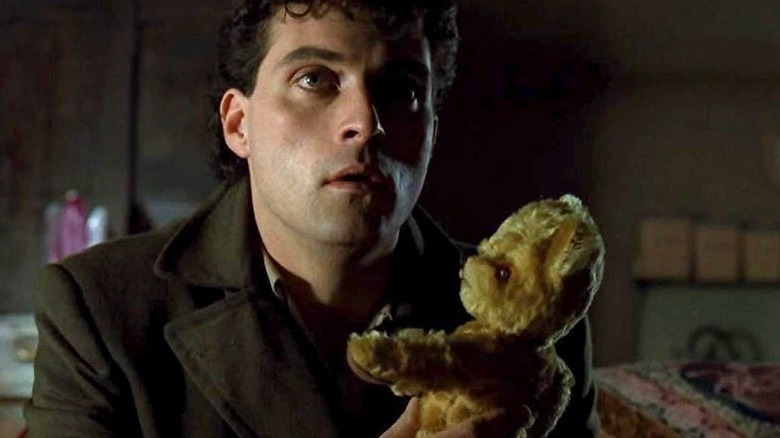Sci-Fi Box Office Bombs That Deserve A Second Chance
As we emerge from the other side of the pandemic, a bunch of big budget science-fiction franchises are about to return to the big screen: Denis Villeneuve's adaption of "Dune," Lana Wachowski's "Matrix 4," James Cameron's "Avatar 2: The Klumps," and Patty Jenkins' contribution to the eternal Star Wars juggernaut, "Rogue Squadron."
But a big license and major studio backing is no guarantee of success. "Solo" famously underperformed, as did David Lynch's "Dune" long before it. However, box office receipts are not a gauge of quality. Plenty of gems slip by unnoticed, while inferior works clog up the multiplexes and streaming services.
What follows is a list of films that dramatically underwhelmed in terms of ticket sales, but deserve a second chance. Some were poorly marketed, some were so niche that they'd never be hits, and some simply got lost. Still, they deserve your love (and don't worry, I'll keep the details on each film as spoiler-free as possible).
Underwater
"Underwater," the Kristen Stewart vehicle about a catastrophe at an underwater drilling facility, is an odd first entry on this list. It unashamedly wears its influences on its diving suit sleeve, but is a weaker film than those that inspired it. "The Abyss" is better at creating tension on a doomed underwater base, and "Alien" does a superior job with its setting's claustrophobia and ravenous chitinous beasties.
By contrast, "Underwater" is, for the most part, workmanlike. The acting's fine, the sets are convincing, and the cast is interesting enough. Like the final act of "28 Days Later," it feels like a "best of" mixtape of movies you like — perfectly adequate, nothing extraordinary. Stewart was always a better actor than her "Twilight" detractors gave her credit for, so the fact that she convincingly holds the film together is no surprise. Still, she's no Ripley.
And then, in the final act, "Underwater" pulls off a move so audacious that genre fans will rush to the internet to check that they've just seen what they think they saw. With that memorable ending, the whole film is elevated, and becomes worth checking out.
Annihilation
Writer-director Alex Garland doesn't have the greatest luck at the box office, this being the first of two of his films on the list. Cerebral sci-fi is just hard to sell to audiences. Critical acclaim is great, but for every success — "Arrival," for example — you'll find a failure like "Gattaca" and "A Scanner Darkly." Films like these tend to do better on home release, but they often get lost in the shuffle.
While they had opposite fates at the box office, "Annihilation" actually shares a certain amount of DNA with "Arrival." Both are led by a strong and determined woman searching for answers. Both are traditionally more introspective than standard sci-fi films, using the genre to reflect on human nature.
In "Annihilation," the ever-reliable Natalie Portman plays Lena, a biologist and soldier leading an all-female team of scientists on a mission to find out what lurks behind the "Shimmer," a mysterious phenomenon that covers the American coastline, and to locate her lost husband. It's a different kind of alien invasion movie, and an altogether more tranquil one. That said, there are some disturbing moments, especially one in particular concerning the Shimmer's weird hybrid creatures. If you've seen the film, you know. If you haven't seen it yet, you need to know.
Blade Runner 2049
Given how influential it's been on modern science fiction cinema, it's amazing that "Blade Runner" was considered a flop — and doubly astonishing to think that, years later, its critically-acclaimed sequel disappointed all over again. "Blade Runner 2049," set 30 years after Ridley Scott's original, sees Ryan Gosling play K, an artificial being (replicant) tasked by the LAPD to hunt down rogue members of his own kind. A routine case leads to a revelation that could cause a war between humans and replicants, and K is ordered to hide the truth.
Director Denis Villeneuve had already proven his sci-fi credentials with the masterful "Arrival," and "Blade Runner 2049" is as striking as its predecessor. It's nothing short of beautiful. A flight above skyscrapers packed so tightly that the gaps between them resemble cracks in a desert floor is a particular highlight. Contentious opinion: I prefer "Blade Runner 2049" to the original. The narrative is stronger, and it didn't need a multitude of director's cuts and optional voiceovers to achieve the director's powerful vision.
Villeneuve's "Dune" is due to be released later in 2021, with the French-Canadian auteur taking the roles of director, writer and producer. For the sake of potential sequels, one hopes that it fares better at the box office than "2049."
Edge of Tomorrow
In hindsight, "Edge of Tomorrow" feels like the punchline of a "Producers"-style joke. Take a brilliant Japanese science-fiction novel with a memorable title, "All you Need is Kill." Throw in a huge budget and add Tom Cruise. Season and stir until you've got a hit.
Unfortunately, Warner Brothers seemed to go out of its way to make the movie's release as mediocre as they could. They named it "Edge of Tomorrow," three words so bland and uninspired that they could have been created by a random sci-fi film title generator. The trailer was dull, making it look like another generic Tom Cruise action vehicle. And the pièce de resistance, the tagline on the posters — "Live, die, repeat" — was bigger than the title of the movie itself, giving the film a weird anonymity.
But far from being another identikit vehicle for an assortment of Tom Cruise stunts, "Edge of Tomorrow" is both smart and witty, with an inspired take on time travel. Cruises plays Major Cage, a PR officer with no combat experience, who is thrown into a war against a mysterious invading species. When he dies and is resurrected at an earlier point in time, he realizes that he's stuck in a time loop, which he uses to his advantage to both survive and conquer the attacking aliens. "Edge of Tomorrow" did eventually recoup its budget, so it isn't as much as a flop as other movies on this list, but it deserved so much better. There are rumors of a sequel – here's hoping they call it "Live, Die, Repeat, and Repeat" and not "Edge of Tomorrow 2."
Dredd
This one is dear to me. As a longstanding reader of the anthology comic "2000 AD," I'd been waiting for a Dredd adaptation forever. Stallone's "Judge Dredd" was not that movie. Alex Garland's "Dredd," however, was everything I could have hoped for. Despite a low budget and a relatively unimpressive Mega City One skyline, it captures the themes of the comic perfectly.
And then the movie came out, and a perfect storm of factors kept audiences away. It was only released in 3D, just as the craze was dying a (well-deserved) death. A poor promotional budget meant that a lot of people thought it was a sequel to the Stallone actioner. It came out right after the similarly-themed Indonesian action film, "The Raid."
"Dredd" is the story of a future city gone wrong. Crime runs rampant, and the streets are patrolled by the Judges, the ultimate arbiters of the Law. Judge Dredd is the most renowned of them all, and we follow him and his newly assigned rookie, Anderson, as they deal with what should be a standard case. "Dredd" is violent, smart, and satirical, everything that the comic has been doing since 1977. Watch it and lament that it'll never get a much-deserved sequel.
Under the Skin
Despite the draw of Scarlett Johansson, "Under the Skin" always seemed fated to be a commercial failure. A cerebral art-house movie loosely based on a critically-acclaimed yet relatively obscure novel by Michael Faber, it was never destined to fill seats in a multiplex. Nonetheless, "Under the Skin" is worth your time, if only as an experience as opposed to a traditional narrative. Prior knowledge of the novel will give more weight to some of scenes, but I personally feel it's a film best encountered cold.
In "Under the Skin," a barely recognizable Johansson plays the Female, an enigmatic figure who travels between towns, picking up single men. Each man is led into a mysterious black void where they are submerged in an oily black mass.
The movie veers wildly between styles; traditional cinema nestles side-by-side with guerilla filmmaking techniques. Some of the scenes were filmed in secret, showing Johansson interacting with people blissfully unaware that they're in a movie. One scene featuring a disfigured potential victim highlights Adam Pearson, neurofibromatosis sufferer and long-time campaigner for support of people with deformities. Your mileage may vary wildly with this one — I'd argue it's the most divisive of any film on this list. Its title is no coincidence; scenes from this one will stay with you, truly getting under your skin.
Dune
"Dune" had been languishing in development hell long before producer Dino De Laurentiis offered it to David Lynch, who had proven he could make mainstream movies with "The Elephant Man." Ridley Scott was set to make it at one point, as was Alejandro Jodorowsky, but it was Lynch who eventually saw it to doomed fruition.
"Dune" is based on Frank Herbert's epic sci-fi series, which was five books long when the film arrived. It's a tale of political machinations and greed, of the rise and fall of empires. Bringing an arguably unfilmable book to the screen was ambitious, to say the least. It had a (no pun intended) stellar cast and a budget that could do the sprawling story justice, but a reduced runtime meant Lynch was forced excise huge chunks of plot. The convoluted result left new viewers cold, relying too much on knowledge of the source material to make any sense.
I find the movie fascinating and watchable as a failed experiment. Its visual effects range from spectacular to weak (the low-resolution, blocky energy shields that the characters wield end up making them look the TARS droid from "Interstellar"), but the acting and score are worthy of note and praise.
Children of Men
You often hear about the prophetic nature of science fiction, but there's a certain eeriness to the prescience in Alfonso Cuarón's "Children of Men." Some of that is due to research. The Shard building features in London's skyline even though it wouldn't start construction until three years after the movie's release. The lead character wears a London Olympics 2012 sweatshirt, even though the movie came out in 2006. The tone uneasily predicts the mood that ultimately settled on England in the 2010s: a grim, oppressive funk that struck after the optimism of the Olympics faded, replacing it with the alienation of Brexit and the rise of right-wing politics.
In "Children of Men," Clive Owen plays Theo, a disillusioned bureaucrat. Ecological disaster has rendered mankind infertile, with the last child born some 18 years earlier. Theo is dragged back into a cause he's long since abandoned and finds himself the unlikely — and somewhat reluctant — champion of the planet's last hope.
Based on P. D. James' 1992 novel, "Children of Men" is a bleak look at a future that no longer seems that far away. It's not relentless — there are moments of joy in this grimdark reality, mostly provided by Theo's old friend, played with aplomb by Michael Caine. From a technical perspective, it's masterful, too. There are several one-take how-the-hell-did-Cuarón-do-that set pieces that you will struggle to tear your eyes away from. From great darkness comes occasional beauty.
Dark City
First there was darkness. Then came the strangers.
It's approaching the end of the '90s, and your film's about to be released. It's set in a city only ever seen in darkness. Your protagonist is a likeable everyman who is about to inadvertently reveal a grim truth: reality is a lie, and the world is the malleable plaything of a mysterious race who holds mankind as unwitting slaves. Our hero must learn how to manipulate reality, then use his powers to try and free ignorant people from enslavement. The problem? "The Matrix" will do the same thing a year later — and it'll have the advantage of three times your budget, attention-grabbing bullet-time effects, a great soundtrack, and Keanu Reeves in a trench coat.
"Dark City" tells the tale of John Murdoch (portrayed by Rufus Sewell), a man wanted for a series of vicious murders that he can't remember committing. Whilst trying to piece together his fragmented memories, John learns about the Strangers, a quintet of mysterious beings lurking in the shadows.
With "The Crow," director Alex Proyas proved that he had distinctive style, one that he ramps up even further in "Dark City." Both feel like a beautifully shot and choreographed music video, every frame carefully designed. They also share aesthetic elements like a permanent night and industrial decay, much like Caro and Jeunet's "City of Lost Children," a flattering — yet not unfair — comparison.
The Blob
The original 1958 movie "The Blob," which stars a youthful Steve McQueen, is a B-movie classic with an amazing Burt Bacharach theme song. It tells a tale as old as time: An old man finds a fallen meteor and pokes it with a stick, causing the gooey extra-terrestrial tourist to crawl up his arm and devour him. As the hungry Blob feeds, it increases in size, until our hero has to confront a huge, ravenous, amorphous mass that threatens to swallow his town whole.
The 1988 remake treads a similar path, albeit with wholesome teenager Steve replaced by town misfit Brian. Played with gusto by Kevin Dillon, Brian's bad boy credentials are never in doubt — he wears a leather jacket and smokes, after all. Despite some very poor back-projection work that dates it terribly, "The Blob" is an absolute gem of a movie. An excellent script by Frank Darabont is reinforced by Chuck Russell's confident direction. The two of them had just come straight from the third "Nightmare on Elm Street" film, and it's clear that they're having the times of their lives chronicling the rampages of the titular gelatinous beast.
There's also some surprisingly icky body horror that's as effective as anything you'd see in a Cronenberg movie, making "The Blob" a welcome reminder of the golden age of practical effects. There are some genuine surprises too, regardless of whether or not you're familiar with the original.
Silent Running
Under-appreciated at the time, the message of "Silent Running" — that of looking after the Earth and its environment — has never been more relevant. Valley Forge is just one spacecraft in a fleet, each one housing enormous greenhouse-like domes that hold the last specimens of Earth's plants and wildlife. Freeman Lowell (Bruce Dern), one of four crew members on the Valley Forge, is an ecologist who spends his days maintaining the plants, hoping to reforest the planet someday. When the fleet is instructed to destroy the plants and return to commercial service, Lowell refuses to stand by and watch that happen.
Along with "Dark Star" and "Alien," "Silent Running" was one of the first sci-fi movies to move away from Flash Gordon-esque rockets and ray guns, replacing the fantasy vibes with a believable, industrial, lived-in look. The crew aren't brave astronauts or interstellar adventurers. They're employees. Space just happens to be where they work.
The environmentalist themes are far from subtle, but the movie refrains from ever feeling preachy or patronizing. Lowell is a desperate man, forced into desperate actions, and his cause is sympathetic enough that we care for his fate. Special mention must go to his co-stars, two service robots named Hewey and Dewey, too. And if the closing scene, accompanied by Joan Baez singing "Rejoice in the Sun," doesn't break your heart, you soul is deader than Earth's last forest.











